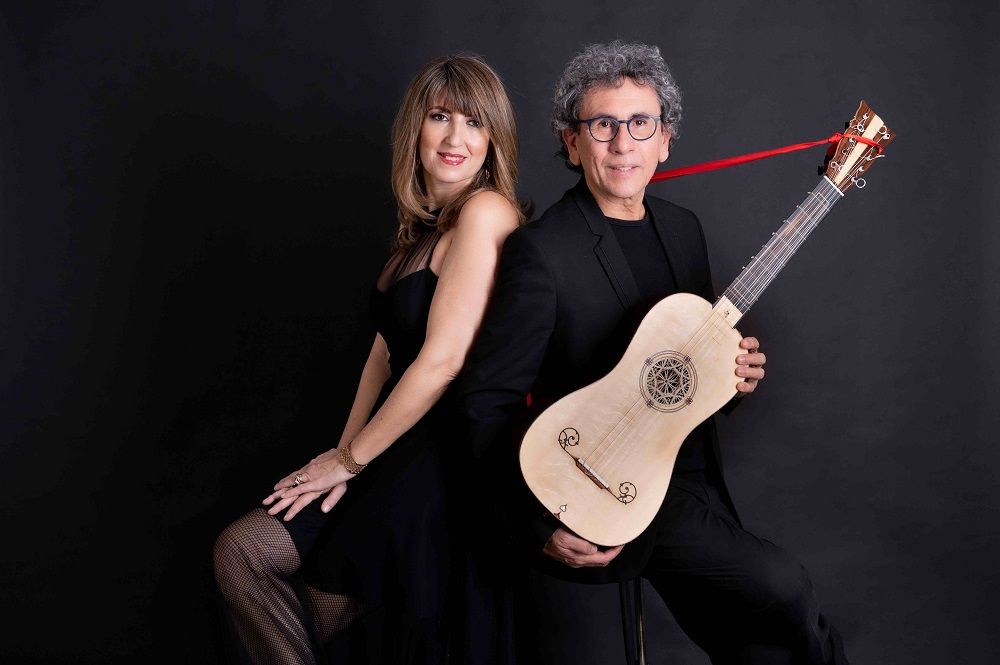Music for archlute, guitar and harpsichord
A lovely disc, beautifully recorded in Palermo, in February 2021. The rewards are many and varied ...

This is a fascinating disc, a musical journey between Italy and Spain of the Baroque era, with Paolo Rigano on the archlute and baroque guitar, and Cinzia Guarino on the harpsichord.
The progamme has been carefully selected. As Paolo Rigano says,
The pieces that have been chosen are the outcome of intensification of research into Spanish, Italian and also Sicilian music that has already been documented elsewhere and now is focused on te mutual attraction between Spain and Italy: the presence of pieces by Santuago de Murcia, an untiting traveller and musical observer, is emblematic in this regard. So Spain is ebodied by guitar and Italy by the harpsichord, while the archlute - which is used chiefly for the accompaniment - is the element hat joins them.

We begin with a famous number, Canario by Caspar Ganz (1640-1710). The arrangement is a delight, rhythms nicely sprung. Ganz was a Spaniard active in Madrid. Here is a very atmospheric and beautifully shot video of their performance. The locations shot in the video will surely please Italophiles:
.. and if you prefer it minus visuals, here it is:
Boccherini’s equally famous Fandango (originally for string quitet and guitar in D, G 448), with some lovely quasi-glissandi from Cinzia Guarino on harpsichord. Her instrument, incidentally, is a fine-sounding harpsichord by the German maker Michael Mietke (died 1719). Guarino herself expounds on this arrangement, which ...
... is performed transcribing the string instrument parts for the harpsichord and leaving the guitar part unchanged next to the harpsichord part: the resulting timbre is particularly homogeneous and allows the guitar to emerge in a management of the parts that is equally transparent, but closer to the Hispanic language to which that dance alludes.
Here it is:
( ... and there’s a most appealing Fandango later in the disc, by Santiago de Murcia, 1672-1739, with a lovely flourish of a cadenza towards the end).
Many an amateur pianist reading this will know Scarlatti’s Sonata, Kk 32, in D-Minor, in the UK principally because of ABRSM repertoire lists. Here the stringed accompaniment , which often reinforces the harpsichord's bassline and embellishes upon it, adds a layer of pure magic. Rigano and Guarino tease out the music’s lachrymose qualities beautifully:
Domenio’s father, Alessandro Scarlatti (1660-1725) has turned up a few times before on Classical Explorer: his complete keyboard works, Volume VII (also Tactus label, performed by Francesco Tasini) and his Sonata for recorder, two violins and continuo on C minor regarding a disc entitled Setticento. His Toccata Nona is heard in a vibrant performance here.
There is an interesting article by J. S. Shedlock on the keyboard music of Alessandro Scarlatti here (if prompted to log in, it is easiest to do so through Google, and you can read up to 100 articles per month for free on the jstor website).
With a title like Toccata dell‘Arcangelo, even if one's forename happens to be Arcangelo, there is a lot to love up too. It is Rigano who does the honours here in Arcangelo Lori’s ’s oh-too-short-but-spellbinding Toccata dell’Arcangelo. Despite the YouTube attribution, it is performed by Rigano seul:
The more extended duet arrangement of Domenico Piccinini’s Ciaconna in Parte variate alla vera Spagnuola brings a bit of a Spanish flavour to the disc, and it is a joyous performance, jauntily rhythmic:
The Giga di Corelli is, I take it, taken from Santiago de Murcia's Passacalles y obras de auitarra por todos los Tonos naturales y acidentales of 1732, a meeting of Corelli's Violin Sonatas with Santiago:
There is nothing more tender on the disc than the Sarabade by Giovanni Zamboni (1664-1721):
... which is balanced by a relentless toccata of a Sonata by Scarlatti, performed this time on harpsichord only. This is Kk 517 in D-Minor, and how one can hear Cinzia Guarino’s finger strength here in her evenness of delivery:
The earliest composer on this disc is a Toccata by Bologna composer Alessanfro Piccinnini (1566-1638), Originally for two lutes, it is performed here by archlute and harpsichord, and includes some lovely ornaments and diminutions:
The last track is the only one that takes us to the one piece of contemporary music: Rigano’s own Correspondence, replete with haunting harmonies. He gives a hint at the title in the following extract:
The project, also because of the isolation and suspension of concert activity due to the pandemic, offers in this disc a condensation of that mixture of sensations and ‘correspondences’ that in a concert can only be hinted at, but in a disc can be verified and experimented with, in an unlimited manner. There is a final, once-only shift to our times in Paolo Rigano’s own ‘“Correspondence’’
A lovely release, beautifully recorded at Sede Associozione Musicamente Palermo in February 2021. While the playing time is low for a compact disc (46"14), the rewards are many and varied.
Here’s a full list of tracks:
1. Gaspar Sanz (1640-1710) Canario
2. Luigi Boccherini (1743-1805) Fandango
3. Domenico Scarlatti (1685-1757) Sonata k 32 Aria
4. Alessandro Scarlatti (1660-1725) Toccata Nona
5. Arcangelo Lori (xvii sec.) Toccata dell’Arcangelo
6. Domenico Pellegrini (xvii sec.) Ciaccona in Parte variate alla vera Spagnuola
7. Santiago De Murcia (1673-1739) Giga de Corelli
8. Giovanni Zamboni (1664-1721) Sarabanda
9. Domenico Scarlatti (1685-1757) Sonata k 517
10. Alessandro Piccinini (1566-1638) Toccata a due liuti & 11. Santiago de Murcia (1673-1739) Fandango
12. Paolo Rigano (1957) Corrispondenze
